☘️ST PATRICK’S DAY – 8 DAY TOUR OF IRELAND – MARCH 16th – 23rd, 2025
Tour Categories: ☘️ESCORTED/COACH & SMALL GROUP TOURS ☘️FEATURED TOURS ☘️SELF-DRIVE/PRIVATE TOURS
☘️ON THE MARCH 17TH, WE WELCOME HALF A MILLION PEOPLE ON THE STREETS OF DUBLIN FOR THE ST PATRICKS DAY PARADE, FEATURING PARTICIPANTS FROM AROUND THE WORLD.
FAMILY GROUP RATES AVAILABLE – PLEASE CLICK HERE TO CONTACT US
 Dublin
Dublin
Explore Dublin’s Fair City at leisure on your day of arrival, Your hotel will be within walking distance of the City Centre.
St. Patrick’s Day Holiday
As the one National Holiday that is celebrated in more countries around the world than any other, St. Patrick’s Day is the day when everyone wants to be Irish.
For two hours you will enjoy an awesome display of creative talent as the national St. Patrick’s Festival Parade snakes its way through the City Centre. International and Irish marching bands join performers, dancers and street theatre companies to present a wonderfully entertaining parade.
The parade is a piece of moving theatre, complete with its own Creative Director. Colorful costumes flamboyant performances and outstanding musical talent will be on show.
Enjoy the rest of the afternoon at leisure to savour the atmosphere of St. Patrick’s Day.
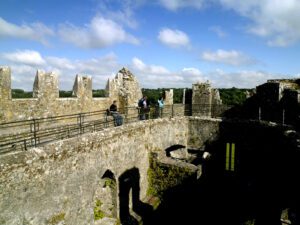
Blarney Castle and Blarney Woollen Mills
When you depart Ireland’s Capital you will travel to County Kerry. En route, stop in the town of Blarney to visit Blarney Castle. Here you will find the legendary Stone of Eloquence. Kiss it & you’ll never again be lost for words. Enjoy some time for shopping at Blarney Woollen Mills.
The presence of the Woollen Mills during the famine shielded Blarney from the worst effects of the famine, due to its employment of local workers. In 1976 Chris Kelleher, himself a mill worker, bought the old mill property.
Within a short period of time Chris & his family transformed the mill into what is perhaps the largest quality craft shop in Ireland.
The Ring of Kerry
Enjoy a superb tour of the Iveragh Peninsula, which will give you the opportunity to discover the Ring of Kerry. Taking in spectacular scenery such as mountains, peat, bogs, lakes and magnificent views of the Atlantic Ocean.
Leaving Killarney pass through Killorglin, famous for its Puck Fair, then to Glenbeigh where the cliff road affords panoramic views of the Dingle Peninsula & Dingle Bay.
Passing through the peat bogs one arrives at the sea town of Waterville.
 Continue to Sneem Village, famous for its brightly coloured houses. Next today enjoy transportation of a different kind! A pony and trap (also known as a Jaunting Car) helps you discover areas of Killarney National Park that you might not otherwise visit.
Continue to Sneem Village, famous for its brightly coloured houses. Next today enjoy transportation of a different kind! A pony and trap (also known as a Jaunting Car) helps you discover areas of Killarney National Park that you might not otherwise visit.
Relax aboard a jaunting car as your Jarvey (driver) takes you through the magnificent scenery of the National Park. Today enjoy dinner on your own in one of the many restaurants or pubs in Killarney town.
When you depart Kerry you will travel towards Galway via the Cliffs Of Moher and The Burren.
Cliffs of Moher
Situated on the Atlantic Ocean and bordering the Burren Area, the Cliffs of Moher are one of Ireland’s most spectacular sights. (Admission to the Cliffs and the Visitors Center is included in your Tour price)
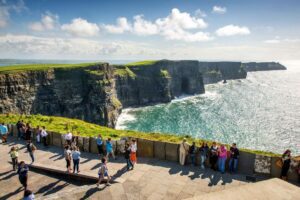 Standing 230 metres above the ground at their highest point and 8km long, the Cliffs boast one of the most amazing views in Ireland.
Standing 230 metres above the ground at their highest point and 8km long, the Cliffs boast one of the most amazing views in Ireland.
On a clear day, the Aran Islands are visible in Galway Bay as well as the valleys and hills of Connemara.
O’ Brien’s Tower
To the south of the cliffs is Hag’s Head and was once the site of a castle. The cliffs reach their highest point just north of O’ Brien’s Tower.
Cornelius O’ Brien, a descendant of Brian Boru (he who defeated the Vikings in battle), built a Tower at the cliffs in order to enjoy some tea with his lady friends.
The Tower is adjacent to the sea stack, Breanan Mór, which stands over 70 metres above the foaming waves and is home to some of the Burren’s wildlife.
Continue onto Doolin for lunch and a session.
Doolin, Co. Clare
Doolin is a charming small seaside village on the north-west coast of County Clare ~ set against the rugged Atlantic Ocean and surrounded by the spectacular bare limestone landscape of the Burren.
Traditionally a fishing village, Doolin is now renowned world-wide as the traditional music capital of Ireland.
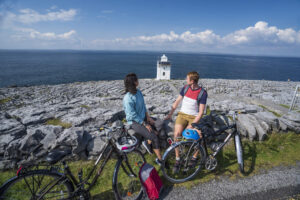 The Burren, Co. Clare
The Burren, Co. Clare
This afternoon you will explore the Burren region.
The Burren, part of which forms the 100 square km Burren National Park, is a unique place. It is a Karst limestone region of approximately 300 sq. km, which lies in the North West corner of Co Clare.
It is composed of limestone pavements, which have been eroded to a distinctive pattern. This pavement is criss-crossed by cracks known as grykes in which grow a myriad of wild flora and under which are huge caves and rivers which suddenly flood when it rains.
The Burren contains dozens of megalithic tombs and Celtic crosses as well as a ruined Cistercian Abbey dating back to the 12th century.
You will discover small villages abandoned during the famine period and green roads on which you can walk for miles without ever seeing a car.
 The flora on the Burren is a mixture Arctic and Mediterranean and rare flowers such as gentian, orchids and bloody cranesbill are the rule rather than the exception. The Burren is truly an exceptional part of Ireland.
The flora on the Burren is a mixture Arctic and Mediterranean and rare flowers such as gentian, orchids and bloody cranesbill are the rule rather than the exception. The Burren is truly an exceptional part of Ireland.
Once in Galway you won’t want to miss an evening of music in local pubs.
Connemara Region
Connemara is a land of lakes and rivers, bogs and mountains. A land of small villages where Gaelic is still the spoken language and where little has changed little since the beginning of time. It is without a doubt the wildest and the most romantic part of Ireland.
Connemara is a vast peninsula bordered by the arid and rocky coastline of Galway Bay in the south ~ a land characteristic for its stone walls and thatched cottages.
On its northern shore the land is harsher and more secret, with spectacular views of the Ocean and the beautiful fjord of Killary Harbour, as well as the steep mountains overlooking numerous lakes and large bog areas. Connemara is a real paradise for Nature lovers and those in search of strong emotions.
 Kylemore Abbey, Co. Galway
Kylemore Abbey, Co. Galway
Visit to Kylemore Abbey. (Admission is included in the cost of your Tour)
Kylemore Abbey is located in the Kylemore Pass in Connemara. Mr. A. Mitchell Henry built the House in 1868, after having spent his honeymoon in the area. The architecture is best described as neo-gothic and the house still displays all the characteristics of that period.
One of Kylemore Abbey’s most famous features is its miniature cathedral, built in 1870 and known locally as the Gothic church.
Today, the abbey is home to the Irish order of Benedictine nuns. They bought the house in 1920, having fled their convent in war-torn Belgium in 1914. They established a private school for young girls, which today is the renowned Kylemore Abbey International School for young girls.
 Facilities at Kylemore include a visitor centre, an exhibition housed in the main reception rooms of the house and a video which takes the visitor through the history of the house and its occupants.
Facilities at Kylemore include a visitor centre, an exhibition housed in the main reception rooms of the house and a video which takes the visitor through the history of the house and its occupants.
Galway
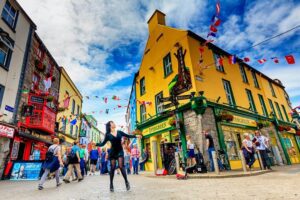 Continue on along Shop Street to see the splendor of the rich merchants’ houses during the time that they controlled the commercial life of the City, Lynch’s house being an excellent example.
Continue on along Shop Street to see the splendor of the rich merchants’ houses during the time that they controlled the commercial life of the City, Lynch’s house being an excellent example. 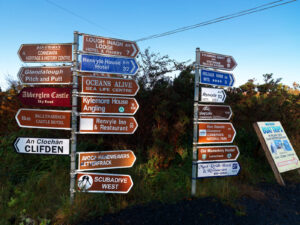 Anyone who knows the song ‘Galway Bay’ will be familiar with the Claddagh, previously a fishing village of thatched cottages, now an area just outside the city centre.
Anyone who knows the song ‘Galway Bay’ will be familiar with the Claddagh, previously a fishing village of thatched cottages, now an area just outside the city centre.Galway Cathedral
Trip ID:0623200

